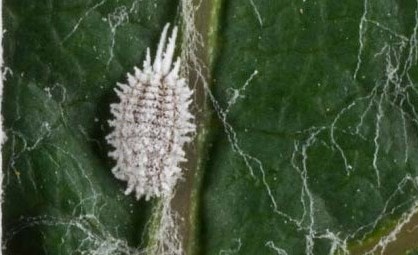Improving the outcomes of mealybug insecticide use in vineyards
Vaughn Bell, The New Zealand Institute for Plant and Food Research Limited
Andrew Blakeman, AJB Solutions NZ Limited
Mealybugs are economically important insect pests in vineyards. A by-product of their feeding is honeydew, which can lead to the development of black sooty mould on vine leaves and bunches. If mealybug infestations are severe and black sooty mould affects wide areas of the vineyard, contaminated fruit can be rejected for harvest.
Mealybugs are also responsible for the spread of grapevine leafroll-associated virus 3 to healthy vines. Leafroll virus is the most important and most widespread viral disease of grapevines in New Zealand. Again, if its influence is widespread in a vineyard, there are negative implications for yield: it can delay harvest, reduce sugar accumulation and lower fruit quality. Ultimately, wine quality may be downgraded.
To minimise the influence of black sooty mould and leafroll virus, it is important that mealybug numbers in the vines remain low. For many wineries, achieving and sustaining this result means it is important to develop and implement an effective insecticide plan.
With the aim of reviewing and improving mealybug insecticide results, the Bragato Research Institute recently approved funding for a research project for a period of 3 years. The project has four primary objectives:
- With a focus on the mealybug insecticide active ingredients, buprofezin and spirotetramat, we will review the best practice recommendations outlined in fact sheets produced by New Zealand Winegrowers and the chemical companies.
- From objective 1, we will develop an inventory of the key recommendations from each fact sheet for each active ingredient, to compare them and to identify inconsistencies that might cause confusion for end-users.
- We will identify 10 commercial vineyard blocks situated in Marlborough. We will work closely with the growers for the duration of the study to support them to optimise spray management outcomes, including sprayer setup. Annual vine leaf assessments per site per year will estimate mealybug abundance. This will be either a measure of spray management success or a catalyst to review/change the spray programme.
- We will use the lessons learned from the above objectives, and the resulting broad-based data set, to inform the development of a nationwide technology transfer programme aimed at optimising spraying strategies.
We are currently working to identify suitable study sites, with numerous parties approached to gauge their willingness to participate.
In the years leading up to this project, the grower response to mealybugs will have differed between sites. There will be those where mealybug insecticides have never been applied to the vines or if they have, applications were incomplete and therefore not in accordance with recognised best practice.
At other sites, the use of mealybug insecticides will have included active ingredients such as buprofezin (e.g. Ovation®, Mortar™) and/or spirotetramat (Movento®). Both these active ingredients are compatible with integrated pest management, so they are unlikely to have disrupted beneficial insects important to mealybug biological control.
In a third category of sites, a mix of active ingredients will have been applied to the vines. Spray diaries will record the use of so-called ‘softer’ chemistries such as buprofezin and spirotetramat, plus one or more applications of broad spectrum active ingredients such as prothiofos (e.g. Tokuthion®) and chlorpyrifos (e.g. Lorsban®) for mealybug management, or lambda-cyhalothrin (e.g. Karate® Zeon) for grass grub control. The application of these latter products, particularly over multiple years, is incompatible with biological control and might explain the mealybug outbreaks observed in at least some Marlborough vineyards in recent years.
By reviewing several years of spray diary data from each study site, we will gain an overview of what chemistries, if any, were used against mealybugs. Advice specific to each participant will aim to remedy any spray application deficiencies identified. Also, by checking the spray equipment and its setup, we will evaluate whether it is fit-for-purpose, based on factors such as vine planting density. If necessary, changes will be recommended.
Having interacted closely with each participant to review their insecticide spray programme and sprayer setup, the ultimate measure of the project’s success will be the fate of mealybugs in vines in the target area per site. By aiming to resolve the inadequacies identified, the expectation is that the changes implemented by each practitioner will reduce the numbers of mealybugs in the vines.
The review of fact sheets and results from the anonymised study site will be the platform upon which a comprehensive technology transfer programme will be developed. Starting in Auckland in mid-2020, the ‘Mealybug Spray Day’ annual road trip will visit various winegrowing regions throughout the country, in what will be interactive events. Presenters will share insights, anecdotes and lessons learned during the study. Hence, having drawn on the good and bad experiences of others, the project will deliver mealybug management recommendations to benefit study participants and the wider sector.
This article first appeared in the February/March 2020 issue of the New Zealand Winegrower Magazine.

















